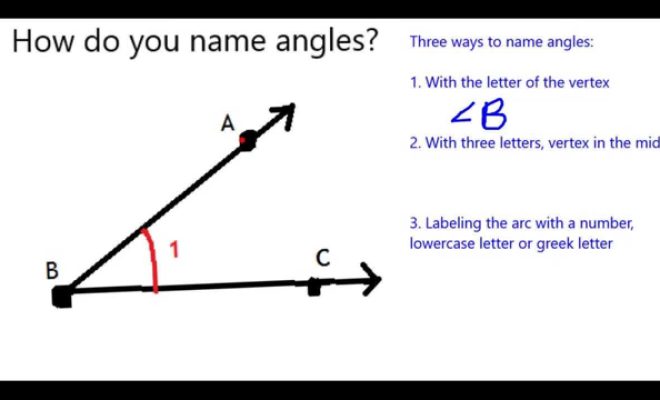How to Name an Angle

Angles are fundamental elements in geometry, and naming them correctly is essential for clear communication and understanding. Here are 11 steps to help you name an angle with precision:
1. Identify the angle: Locate the angle you want to name within a geometric shape, diagram, or real-world object.
2. Label the vertex: The vertex of an angle is the point where two sides meet. Assign a capital letter (e.g., “A”) to this point, as this will represent the vertex in the angle’s name.
3. Label the sides: Name the two sides that create the angle by assigning points (usually lowercase letters) to their endpoints. Ensure that each side has one endpoint coinciding with the vertex.
4. Use simple names for common angles: Angles with specific measures such as right angles (90°), acute angles (less than 90°), obtuse angles (greater than 90°), and straight angles (180°) can be described using the terms “right,” “acute,” “obtuse,” and “straight.”
5. Begin naming from the vertex: Start naming the angle by mentioning its vertex. For example, if you labeled your vertex as “A,” begin with “Angle A” or simply use the symbol ∠A.
6. Include side endpoints for clarity: To provide more detail when describing an angle, include the side endpoints alongside the vertex point. An example would be ∠ABC, where A is at one endpoint, B is at the vertex, and C is at the other endpoint.
7. Use numerals for identification: When there is more than one angle at a vertex or if you want to specify a particular angle within a figure, you can use numerals like ∠1 or ∠2 instead of letters.
8. Measure the angle in degrees: Use a protractor or other tools to find the measure of the angle in degrees. Once you have that value, you can append it to the angle’s name, e.g., ∠ABC = 45°.
9. Utilize Greek letters for plane angles: Sometimes, in mathematics or physics, Greek letters such as α (alpha), β (beta), or θ (theta) are used to represent angles on a plane. Use these symbols when appropriate.
10. Follow conventions for solid angles: When working with three-dimensional shapes and solid angles, use symbols like Ω (Omega) or other established conventions.
11. Practice precision in naming: Ensure that your angle naming remains consistent and follows established standards throughout your work to avoid confusion and make comprehension of geometric concepts easier.
By following these 11 steps, you’ll be able to name angles accurately and effectively, making your geometry work clearer and more precise.


